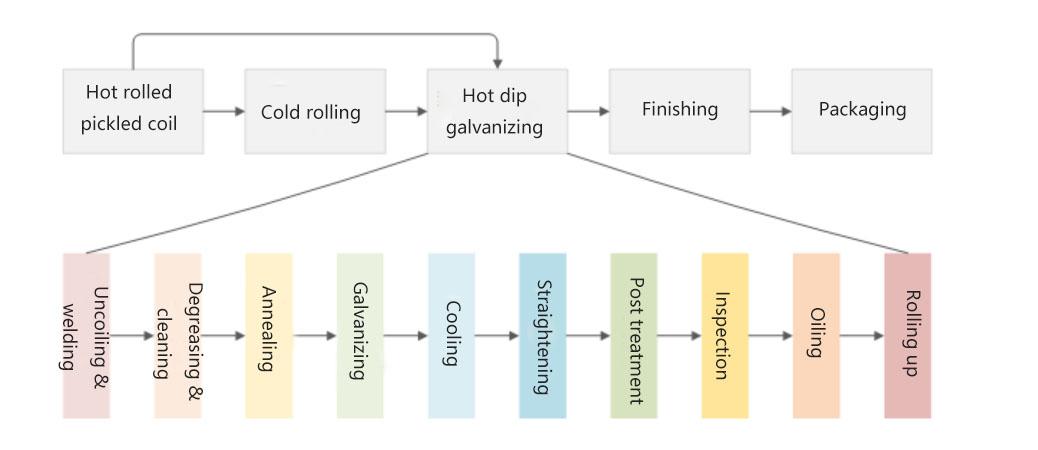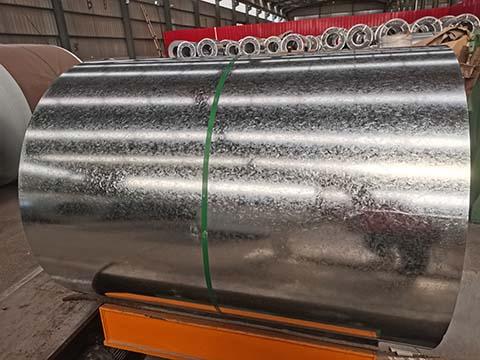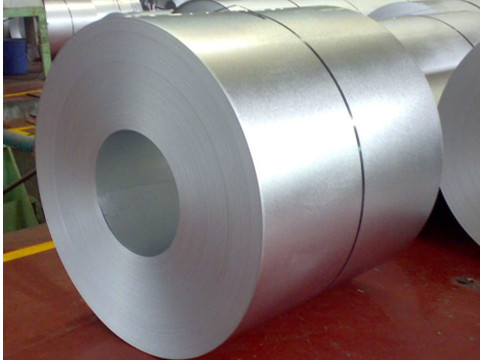10F, Building B, Erqi Center, Erqi District,
Zhengzhou City,
Henan Province, China
Wit:+86 15138685087
(WhatsApp/Wechat)

10F, Building B, Erqi Center, Erqi District,
Zhengzhou City,
Henan Province, China
Wit:+86 15138685087
(WhatsApp/Wechat)
Galvanized steel is made by applying a layer of zinc to the surface of steel or iron to protect it from rust and corrosion. Meanwhile, the smooth and fine zinc coating also offers decoration purposes.
There are two main galvanizing processes, hot-dip galvanizing and electro-galvanizing.This article will focus on the production processes of these two galvanized steels.
Hot-dip galvanizing is the process of immersing the steel or iron in the molten zinc at about 480 ℃ to apply a zinc layer on the surface. Here is the process:
Uncoiling & welding — Degreasing & cleaning — Annealing & Pickling — Drying — Galvanizing — Cooling — Inspection

Hot Dip Galvanizing Process
At Wanzhi Steel, we often use cold-rolled or hot-rolled coils as the base metal.
The base metal is uncoiled and welded first.
The next step is the pre-treatment process, including degreasing, washing, and drying.
Then the steel coil is heated to 700-800 degrees for recrystallization annealing. After that, cool down the metal to 480 ℃.
Finally, it is immersed in a zinc pot under sealed conditions. After cooling and quality inspection, the galvanized steel will be rolled up for sale.
The hot-dip galvanizing process offers a thick and dense pure zinc layer to protect the base metal from corrosion.
Electro galvanizing, also known as cold galvanizing, is the process of forming a zinc layer on the surface of steel or iron by electrolysis.
It adopts an electrochemical method. Regarding zinc ingot as the anode, the zinc atoms lose electrons and become ions and dissolve into the electrolyte. And the steel metal is the cathode. The zinc ions get electrons on the steel and become zinc atoms and are deposited on the surface of the steel to form a zinc coating.
Before electroplating, it is necessary to remove the grease and oxides on the base metal to ensure its adhesion. Here is the process:
Degreasing (at 5 -40°C) — Washing with water (at room temperature) — rust cleaning — Washing with water (at room temperature) — Electro galvanizing (5-60°C) — Washing with water (at room temperature) — Passivating — Washing with hot water (≤70°C) — Drying — Cooling — Quality Inspection

Hot Dip Galvanized Coil

Electro Galvanized Steel
In general, electro-galvanizing is through an electrode reaction, while hot-dip galvanizing is galvanizing by immersing raw materials in a zinc bath, which is a physical reaction and intermetallic reaction. So there is a layer of intermetallic compound and a zinc layer on the surface of HDG steel.
Moreover, the zinc layer of electro-galvanized steel is thinner (≤30 g/㎡), and that of hot-dip galvanized steel is thicker, say 30-600 g/㎡. That’s why HDG has better corrosion resistance than EG. However, the surface EG is smoother than HDG. At Wanzhi Steel, the maximum zinc layer is 275 g/㎡ (Z275 or G90). In terms of their uses, electro-galvanized sheets are suitable for small parts. While hot-dip galvanized sheets are suitable for large parts and equipment. HDG products are widely used in construction, chemical facilities petroleum, municipal facilities, agricultural facilities, railways, and other fields. Welcome to contact us for more details!
he thickness of the zinc layer directly affects the corrosion resistance and appearance quality of galvanized steel.Too thin a coating has insufficient anti-corrosion performance, while too thick a coating may affect the appearance and increase costs.Therefore, when choosing the thickness of the zinc layer, you should consider your budget and application scenarios.
Choose a suitable galvanizing process according to the specific needs and uses of the product.For example, hot-dip galvanizing is a better choice for large components and thick plates, while electrogalvanizing is more suitable for thin plates and small parts.
When choosing a manufacturer, it is necessary to review it, including qualifications, reputation, quality certification, etc.

Customer Reviews Whatsapp
Wanzhi Steel has two hot-dip galvanizing production lines and one electro-galvanizing production line, as well as multiple slitting, cutting, profiling and other equipment.Therefore, the galvanized products we can provide include galvanized steel coils, galvanized steel sheets, galvanized steel strips, galvanized corrugated sheets, etc. Full specifications and models to meet the needs of various projects.
As the most professional galvanized steel manufacturer in China, we can provide you with the most competitive wholesale prices while ensuring product quality. If you have any needs, you are welcome to contact us at any time.





